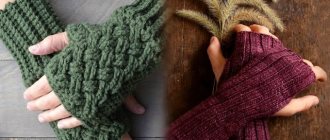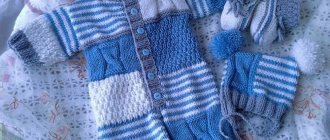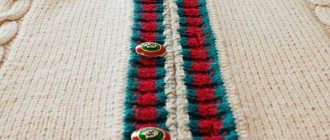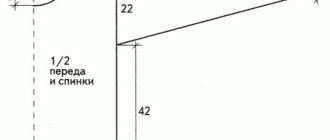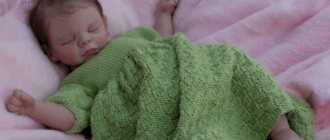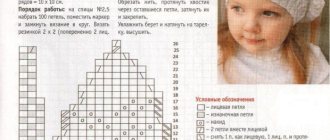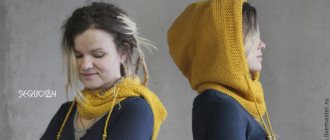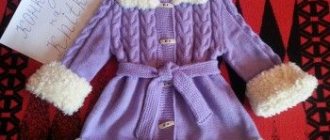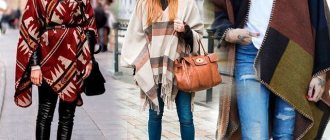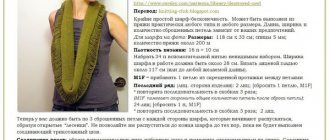- 54387
- 13-10-2020
- Author: Mysekret Team
- 0
During the cold season, there is no better option than knitting a beautiful sweater for your child. Every boy will be happy to wear a bright, warm and pleasant sweater, which means it’s time to choose several interesting knitting patterns to choose from.
It should be noted that original sweaters will not necessarily require a lot of experience or special professional skills from the knitter. Many popular models are knitted with the simplest patterns, and at the same time they look beautiful and interesting. Therefore, regardless of the experience of the needlewoman, there should be no difficulties with knitting a sweater for a boy - you just need to follow the recommendations for knitting patterns. In this matter, the main thing is that the young man likes the style, and then he wears the knitted product with pleasure.
Jacket with a hood and a cat pattern
This interesting knitted sweater with a hood for a boy is suitable for young people 7-8 and 10 years old. The front of the sweater is decorated with intarsia (a cat's face), and the hood is a striped cat's tail ending in a braid of thread.
We knit a cat according to the pattern below. The easiest way to knit such patterns is from separate balls, each section has its own ball. To avoid holes in the pattern, cross the thread on the wrong side, but do not tighten it too much. We always make sure that the drawing does not decrease as we work.
To work you will need:
- Cotton yarn 100% (10 (7-8 years old) and 12 skeins (8-10 years old) – 50 g/50 m). light gray color.
- Wool yarn, black and white - 100 g each.
- Knitting needles 3 and 3.5 mm thick.
- Additional 3.5 mm knitting needle.
- Pins or stitch markers.
We knit in 2 threads. It would be ideal to knit a 10/10 cm “tester” to determine how many stitches you need to cast on, since the description does not indicate the exact name of the threads. Most likely, these are “violet” type threads.
The knitting density is indicated as: 21 p. / 29 r. Corresponds to 10/10 cm . Designations: knit - k, purl - p, loop - p. Main knitting - knit stitch.
Back
For 3 mm knitting needles. cast on 94 (102) sts with light gray yarn, knit 1 p/1 rib. Elastic band 3.5 cm. – 10 rows. We switch to 3.5 mm knitting needles. Next, knit in stockinette stitch. Knitted 123 (134) rubles. – 42(46) cm. From the elastic we close the middle 32 sts for the neckline. Find the middle of the row and decrease 16 sts on one side and the other from the center. Next, leave one half of the work for extra. knitting needle, and on the other half we close from the inside in every second r. 2 times 1 p. Next, close in this r. remaining 28 (32) shoulder stitches. Knit the second half symmetrically from the auxiliary needle.
Shelf
Make the elastic band the same as we did on the back. Next, we begin to make a drawing of a cat: on 3.5 mm knitting needles. Next, we stop at the front river. and make a pattern: 18 (22) sts in light gray, 58 sts according to the pattern, 18 (22) sts in light gray. For convenience, find the middle of the picture and mark it with a pin (arrow in the picture). Next, we knit according to the pattern. When the pattern is completed, use stockinette stitch in light gray (primary) color.
We knit 110(120) rows 37(41) cm. From the elastic we close the middle 24 sts to decorate the neck of the product. First we will make the left side of the shelf. To create a rounded neckline, you need to close it on the inside at the beginning of each r. 1 p. So we close until (20 r.) until 30 (34) p. remain on the knitting needles, this is the shoulder. Close these steps. Make the right part symmetrically with the left.
Sleeves
We cast on the knitting needles 3 mm. light gray thread 44 p. and knit 10 r. elastic band 1/1. Next comes the stockinette stitch. In the first r. add 6 p., you get 50 p., then in every 5th p. add 1 stitch on both sides. We knit this way until there are 78 (92) sts on the knitting needles. It turns out 27 (32) cm. From the elastic we close all the sts of the shoulder. The second sleeve is similar to the first.
Hood
We sew the shoulders together with a large needle and gray thread. Next, find the middle of the back and mark it with a pin. for 2 knitting needles 3.5 mm. Along the edge of the neckline we cast on 116 stitches with a light gray thread, (58 stitches on each knitting needle) first we knit on the 1st knitting needle, then on the 2nd and at the end of the work we will sew these 2 halves. In the middle of the front, on the 1st needle, we make a bar with a 1/1 rib on the first 5 loops. We knit the rest of the hood using stockinette stitch. From the back we will add loops and knit them with black and white yarn. If you want to make a regular hood, you can simply knit without adding anything until the height of the 56th row and close all sts. If you want a striped hood, add white and black stripes to the left. Add 1 point in each row. You will get 4 rubles. black yarn, 4 r. white, several stripes. We do this:
- 1st row: 58 p. persons. gray yarn, add 1 stitch of black yarn.
- 2nd row: 2 p. Black Ave., 58 p. gray ave.
- 3rd row: 58 sts. gray ave., 3 p. persons. black ave.,
- And so on.
They tied it up to 56 rubles. and close the st. On the 2nd knitting needle, do everything the same as on the 1st. Don't forget 5 stitches of elastic at the beginning. Next, we make, if desired, a braid of 20 threads of 2 or 3 colors, tied at the bottom with black thread.
Assembly
Sew our hood inside out, not forgetting to insert a pigtail. Next, unfold the sleeves and sew them to the front and back. Sew the inside seams of the sleeves, and then the side seams of the product.
Analysis of knitting
It is best to start knitting any item from the back and sleeves, since during the knitting process there may not be enough yarn (then you can knit the front, for example, make it two-color) or you decide to somehow change the front of the product during the work process. This way the base in the form of sleeves and back will be completed. Only the front will remain.
- For the back, we cast on 94 loops with blue yarn using the Italian technique. This is a very convenient way to cast on loops. The video below shows everything clearly; even beginners can handle this method.
- We knit an elastic band 4 cm wide, then take red threads and move to the front stitch, adding 15 loops. We make an increase every 6-7 stitches to make it even. We knit 2 rows in stockinette stitch. This is because it turns out to be a transition of 2 colors. If one color were used, then after the elastic band you could immediately start making patterns.
- Next, we disassemble the loops for the base for the pattern according to the scheme: 1 edge, 12 purl, 18 loops for the pattern (Fig. No. 1), 4 purl, 8 loops for the pattern (Fig. No. 2), 4 purl, 15 loops for the pattern (central pattern) (Fig. No. 3), 4 purl, 8 loops for the pattern (Fig. No. 2), 4 purl 18 loops for the pattern (Fig. No. 1), 12 purl, 1 edge.
- Knit according to these patterns up to the armhole. To make an armhole, you need to decrease 9 stitches on each side. Decrease is done in every second row. The first time, decrease 3 loops, the second time - 2 loops, and 1 loop in four rows. There should be a total of 91 stitches left with 4 purl stitches along the edges.
- To get a neckline, you need to close 31 loops in the middle.
Knit the front part in the same way, but leave a slit at the top for the fastener and deepen the neckline by 4 cm. The slit and notch are made as follows:
- The cut is made by closing 15 loops in the middle. But if you close all the loops, you can get a flat medium braid, so you need to close 1 and 2 loops alternately.
- Then each side is knitted separately and a notch is made for the neckline. For it you need to decrease 4 loops once, then 3, then 2 loops and 1 loop 3 times on both sides. The front part should be equal in height to the back.
Sweater sleeves will consist of only 2 types of patterns: pattern No. 1 and 2.
- For the sleeves, you need to cast on 46 loops in the Italian way, knit 4 cm of elastic, then add 8 stitches evenly in the purl row.
- Let's move on to the main pattern. You need to distribute it like this: edge loop, 5 purl, 8 knit for pattern No. 2, 4 purl, 18 loops for pattern No. 1, 4 purl, 8 loops for pattern No. 2, 5 purl.
- Having knitted up to the 9th row, we will begin to increase loops in each 6th row, 1 for the bevel. In total, you need to add 12 loops from each edge. We get 78 loops in the sleeve width.
- In every second row we close the loops.
- Connect the front and back parts at the shoulders.
The collar will be double. First you need to knit it on the reverse side with an elastic band 6 cm wide using blue yarn. Next, we attach the red thread, knit 1 row of facial loops with it, 2nd row of the wrong side - also with facial loops. These 2 rows are knitted so that the collar can be easily folded. Then we knit again 6 cm with an elastic band. We sew the collar to the product.
Let's move on to the straps; for them you need to cast on 26 loops with a hollow elastic band. The loops are knitted in the same way, but on 4 loops.
Sew the loops to one strip, as shown in the photo:
We sew the strips to the cut on the front, then we sew on the sleeves and process the side seams and the seams of the sleeves.
We get an interesting model for a little dandy. Alternatively, this sweater can be made with raglan sleeves by slightly revising the braid knitting patterns.
Classic cardigan for boys
A sweater for a boy made of blue yarn with knitting needles is an excellent option for cool weather. Convenient button closure makes it convenient and versatile. We tried to explain everything in detail, so that the master class is understandable even for beginners. Cardigan sizes for boys: a) 4 years old, b) 5-6 years old, c) 8-9 years old, d) 10 years old, e) 12-13-14 years old.
Abbreviations: row - p., knit - knit., purl - purl., loop - loop, together - vm., edge - hem.
To work you will need:
- Alpaca cashmere yarn (48% alpaca, 52% acrylic), 100 g. – 133 m. – 8-9-11-14-16 skeins.
- Knitting needles 3 mm thick. and 3.5 mm.
- Buttons 5 pieces 20 mm. diameter, buttons 10 mm.
- Needle with a large eye.
The main pattern is the front stitch, the bottom of the sleeves and the bottom of the jacket is 1 k/1 p, the pattern on the front and collar is patent ribbing.
Patent gum, sample.
Scheme for patent gum, option 1.
Patent elastic can have several options, but we chose option 1, it is knitted like this:
We dial an odd number of p.
1st r .: hem., *1 p. and yarn over - remove as purl., knit 1*, repeat from * to *, finish: 1 p. and yarn over - remove, hem.
2nd r .(wr. r.): hem., *1 p. and yarn over - knit in. knits., 1 p. and yo* - remove as purl, repeat from * to *, finish: 1 p. and yo - knit in. faces, edges
3rd r .(knit. r.): hem., *1 p. and yarn over - remove as purl., 1 p. and yarn over - knit in. knit*., repeat from * to*, finish: 1 p. and yarn over - remove as purl, hem. Repeat rows 2 and 3.
In principle, the collar can be knitted with a simple elastic band, k1/p1. or you can use a patent, whichever you prefer.
Samples: 10/10 cm faces. satin stitch – 23 p./30 r., 10/10 cm. Patent elastic band – 22 p./50 r.
Back
We cast on needles with a thickness of 3 mm. a) 79 p., b) 85 p., c) 91 p., d) 97 p., e) 111 p., knit with 1/1 elastic band. At the beginning and end of the first river. – 1 purl. We knit 6 rows like this (2 cm).
Next, we switch to 3.5 mm knitting needles and knit in satin stitch to a height of 24-26-28-31-34 cm, which corresponds to 120-130-140-154-170 r. from the elastic, we make armholes, on both sides you need to close 10 sts: on one side - close 5 sts, 1 in each r., and on the other - 5 sts, 1 st in each r. Knit to the starting point of the shoulder only 14-16-17-18-21 cm, including the armhole. Remaining on knitting needles: 69-75-81-87-101 sts.
We divide the back in half and mark this place with a pin. At a distance from the elastic: 38-42-45-49-55 cm. (162, 178, 192, 212, 234 rubles) we make a neckline, while closing the stitch in the center of the back: 13-15-17-17-21 p., then remove one half (6,7,8,8,10 p.) onto an additional knitting needle, close on the working knitting needle 2 more times, 5 p. each. Then return to the additional knitting needle. knitting needle and knit symmetrically the second half of the neck. Then we decorate the shoulder: at a distance from the elastic 38-42-45-49-55 cm. (166-182-196-216-238 rubles) close on the side. armholes in each second row:
- 2 times 9 p.,
- 2 r. 10 p. each,
- 2 r. by 11p.,
- 2 r. 12 p. each,
- 2 r. 15 p. each
Right shelf
We cast on needles with a thickness of 3 mm. 37-41-43-47-53 p., perform an elastic band 1/1 6 r. (2 cm). Next, we switch to 3.5 mm knitting needles and perform patent elastic:
- 15 rows,
- 16 rub.,
- 18 rub.,
- 20 rub.,
- 22 rub.,
Next, perform 2 rows of faces. satin stitch, then repeat in the same order with a patent elastic band - repeat the same rows 4 times, finishing after 4 repetitions of knits. satin stitch
Further, at a height of 24-26-28-31-34 cm, which corresponds to 120-130-140-154-170 r. from the elastic band, we make an armhole, closing 5 sts on the left - 1 st in each r. 32-36-38-42-48 sts remain on the needle.
Then, at a height of 26-28-31-34-37 cm (130-138-154-170-172 r.), make 1 decrease (beginning of the neckline). To get a beautiful neckline, we must remove evenly: 9-11-11-15-17 stitches along the neckline, do not touch the shoulder yet. Therefore, we remove every 4th r. 1 p. (for all sizes).
Forming a shoulder. At a distance from the elastic band 38-42-45-49-55 cm. (RUR 166-182-196-216-238) close on the side. armholes in each second row:
- 2 times 9 p.,
- 2 r. 10 p. each,
- 2 r. by 11p.,
- 2 r. 12 p. each,
- 2 r. 15 p. each
We knit the left shelf symmetrically to the right one.
Sleeves
We cast on the knitting needles 3 mm. 48-50-52-54-58 sts and knit 5 cm with a simple 1/1 rib. Next, we continue with satin stitch on needles 3.5 mm thick. Our task is to add 16-22-26-28-38 sts along the sleeves. On the sleeve add: in every 4th p. 1 p. This should be done in the middle of the row. We tie it to a height of 20-25-29-32-38 cm, not counting the elastic band. It will be 62nd-76th-88th-98-114 r. from an elastic band.
It turns out in the end at the starting point of the okat - 64-72-78-82-96 sts.
Then we must design the sleeve cap, to do this we decrease on each side:
- 3 times three sts, 4 times two sts, 2 times three sts.
- 2 times four p., 1 r. three p., 3 r. two p., 2 r. three p., 1 r. four p.
- 2 times 4 p., 2 r. 3 p., 1 r. 2 p., 2 r. 3 p., 2 r. 4 p. (abbreviation verbatim: 1 time - 1 p.)
- 1 time 5 p., 1 r. 4 p., 2 r. 3 p., 1 r. 4 p., 1 r. 5 p.
- 1 time 6 p., 1 r. 5 p., 1 r. 4 p., 1 r. 5 p., 1 r. 6 p.
We tied it to a height of 26-31-35-38-44 cm and closed the rest in one r. – 17-18 p. Make the second sleeve symmetrically to the first.
Fastener strip
On knitting needles 3 mm thick. cast on 13 stitches and knit with a simple 1/1 elastic band. All odd r. start and end with two persons. p. We knit a strip with a height of 29-32-35-39-44 cm. Make the second strip similarly to the first.
Shawl collar
For 3.5 mm knitting needles. cast on 93-99-103-107-113 sts and knit with patent elastic. After making 14 r. (3 cm), then close each. sides like this:
- In each 2nd row: *1 time 1 p. and 2 times 2 p.* repeat from *to* a total of 7 times.
- In each 2nd row: *1 time 3 p., 2 times 2 p., then in each. 2nd row: *1 time 1 p. and 2 times 2 p.* – repeat from *to* 6 times.
- In each 4th row: 5 times 2 p and further in each. 2nd 14 times 2 p.
- In each 2nd r.: 1 time 3 p., 2 times 2 p., then in every 2nd r.: *1 r. 1 p. and 2 times 2 p.* - repeat from * to * 6 times, then, 1 p. 1 p. and 1 p. 2 p.
- In each 2nd row: 1 time 3 p., 2 times 2 p., each. 2nd row: *1 time 1 p. and 2 p. 2 p.* repeat from* to* 6 times, then 2 times 2 p.
Knit to a height of 11-11-12-12-12 and cast off 23-25-27-27-31 sts.
Assembly
Sew first the shoulders and sleeve seams, then the side seams. Sew the sleeves into the armholes. Then we sew the strips to the shelves on one side and the other. Find the middle of the back neckline. We are looking for the middle of the collar. We combine these points and pin them together. We sew the shawl collar to the neck, the ends to the straps. We make 5 buttonholes, spreading the 8th stitch first 1 cm from the bottom and the rest - in places of 2 p. persons iron. We sew the buttons opposite the p. To make the collar cover the throat, you can sew buttons in addition to the buttons. The pattern is suitable for boys of all ages, as well as for three and five years old.
Knitted children's sweater for a boy (patterns)
Every mother wants her son to be well dressed, but parents know how expensive high-quality children's clothes are now. And if you know how to knit, this solves many problems with a boy’s wardrobe. Today we invite you to choose a super option for yourself and knit a sweater for a boy. All models with detailed descriptions and diagrams are attached.
Knitting for children is a great opportunity to please your beloved son or grandson. Now in fashion are light green shades (mint, grass), pastel shades (beige, creamy), all shades of gray, blue, lilac.
Mint sweater for a boy
A wonderful knitted sweater in a fashionable color for a boy. Model from a French magazine, from the category: children's knitting for boys. Your son or grandson will certainly like such a beautiful knitted youth sweater for a boy. The knitted sweater is written down in detail, with a description of knitting and patterns. Sizes are given for a) 4 years, b) 6 years, c) 8-9 years, d) 12/13 years, e) 14/16 years.
To work you will need:
- Cabotine yarn (50% cotton, 50% acrylic), 50 g/120 m. 5/6/8/10/11 skeins.
- Knitting needles 2.5 and 3 mm thick, extra. spoke.
We will use knitting patterns:
- Fantasy pattern, repeat 17 loops.
- “Pearl” pattern: 1st row: k1, purl 1, 2nd row: vice versa, over knit. - purl n., above purl. - persons
- Garter stitch.
- Elastic band 1 knit/1 purl.
- Fantasy pattern, repeat 17 loops, diagram:
- Knitting samples: 10 cm of “pearl” pattern - 20 p./36 r.
Back
We start knitting a jumper for a boy from the back. We cast on needles with a thickness of 3 mm. a) 87, b) 93, c) 101, d) 111, e) 119 loops. We knit 4 rows in garter stitch, then continue:
- 12 sts with pearl pattern*, 17 sts with pattern, 6 sts with pearl pattern*, repeat from * to * 2 times, then 17 sts with pattern, and 12 sts with pearl pattern.
- 15 sts with pearl pattern*, 17 sts with pattern, 6 sts with pearl pattern*, repeat from * to * 2 times, then 17 sts with pattern, and 15 sts with pearl pattern.
- 17 sts with pearl pattern*, 17 sts with pattern, 8 sts with pearl pattern*, repeat from * to * 2 times, then 17 sts with pattern, and 17 sts with pearl pattern.
- 20 sts with a pearl pattern*, 17 sts with a pattern, 10 sts with a pearl pattern,* repeat from * to * 2 times, then 17 sts with a pattern, and 20 sts with a pearl pattern. pattern.
- 22 sts with pearl pattern*, 17 sts with pattern, 12 sts with pearl pattern*, repeat from * to * 2 times, then 17 sts with pattern, 22 sts with pearl pattern.
At a height of a) 23 cm (82 rubles); b) 25 cm (90 rub.); c) 28.5 cm (102 rubles); d) 32 cm (116 rub.); e) 34 cm. (122 r) from garter stitch make an armhole, closing each side on each side. 2nd r.:
1 time for 3 points, 2 times for 2 points, and 3 times for 1 point. 1 time for 3 points, 3 times for 2 points, and 2 times for 1 point. 1 time for 3 points, 3 times. 2 p., and 3 times 1 p. 2 times 3 p., 2 p. 2 p., and 3 p. 1 p. 2 times 3 p., 3 p. 2 p., and 2 p. 1 p. each
Remaining: a) 67 p., b) 71 p., c) 77 p., d) 85 p., e) 91 p.
At a distance of a) 34 cm (122 r.), b) 38 (136), c) 43 (154), d) 49 (176), e) 53 (190) from the garter stitch, make the shoulders, closing on each side in every 2nd r.;
- 1 time for 3 points, and 5 times for 4 points.
- 6 times 4 p.
- 4 rub. 4 p. and 2 p. 5 p. each
- 1 rub. 4 p. and 5 p. 5 p. each
- 5 rub. 5 p., and 1 r. 6 p. each
At a distance: a) 37 cm. (134 r), b) 41 cm. (148 r), c) 46 (166), 52 (188), 56 (202) from garter stitch, bind off all remaining a) 21 sts ., b) 23 p., c) 25 p., d) 27, e) 29 p.
Before
We knit the same way as we knitted the back to the armhole. Knitted to the armhole. We have a) 67 p. b) 71 p. c) 77 p. d) 85 p. e) 91 p. At the height:
- 34 cm (122 r),
- 37 (134),
- 42 (152),
- 47 (170),
- 51 (184),
from garter stitch, make a neckline, closing the central ones: a) 11 p., b), c) - 13 p., d), e) - 15 p. Next, we continue each side separately, closing from the neck side in each 2- ohm row:
1 time for 4 p., 1 time for 3 p., and 1 time for 2 p. 1 time for 4 p., 1 p. 3 p., and 2 p. 1 p. 1 r. 4 p., 1 r. 3 p., 1 r. 2 p., and 1 r. 1 p. 1 r. 3 p., 2 p. 2 p., 3 p. 1 p. each
2 r. 3 p., 1 r. 2 p., and 3 p. 1 p. each
At the same time, at a height of b) 38 cm (RUR 136), c) 43 cm (RUR 154), d) 49 cm (RUR 176), e) 53 cm (RUR 190) from the garter stitch we decorate the shoulders, closing on each side in every 2nd row:
1 time for 3 sts, and 4 times for 4 sts. 5 times for 4 sts. 3 times for 4 sts and 2 times for 5 sts. 5 times for 5 sts. 3 r. pr 5 p., and 2 r. 6 p. each
We finish the second side of the neck.
Right sleeve
We cast on knitting needles with a thickness of 2.5 mm: a) 48 sts b) 50, c) 52 sts d) 56 sts e) 58 sts, knit with an elastic band 1 knit/1 purl. 4 cm sleeves. We continue with a fantasy pattern and a pearl pattern, knitting with 3 mm knitting needles.
, making a decrease in the 1st row and placing the loops as follows: a) 15 p. b) 16 p. c) 17 p. d) 19 p. e) 20 p. pearl pattern, 17 p. pattern, a) 15 p. b) 16 p. c) 17 p. d) 19 p. e) 20 p. pearl pattern. We got: a) 47 p.
b) 49 p. c) 51 p. d) 55 e) 57 p.
Add a pearl pattern on each side:
- in every 26th r. 2 times 1 p.
- 24 rub. above: 1 rub. 1 p. and in every 22nd row: 2 times 1 p.
- 20 rub. above: 1 rub. 1 p. and in every 18th row: 4 times 1 p.
- in every 16th r. 7 times 1 p.
- in every 16th row: 2 times 1 p. and in every 14th row: 7 times 1 p.
We get: 51-55-61-69-75 p.
Next we knit the right sleeve of the Sweater model with knitting needles.
At a height of a) 21 cm. (76 r.), b) 25 cm. (90 r.), c) 30.5 cm. (110 r.), d) 36 cm (130 r.), e) 40 cm (144 r.) from the elastic band, form a rounding, closing each side on each. 2nd row:
- 1 time for 3 p., 2 times for 1 p., in every 4th row: 3 p. 1 p. each; 6 rub. above: 1 rub. 1 p., in every 4th p.: 2 p. 1 p. each; and in every 2nd r.: 1 r. 2 p., and 1 r. 3 p. each
- in every 2nd row: 1 time for 3 sts, 2 times for 1 st, in every 4 rows: 7 times for 1 st, and in every 2nd row: 1 time for 1 st. , 1 time for 2 p., and 1 time for 3 p.
- in each 2 p.: 1 time for 3 p., 4 p. 1 p. each; in each 4 p.: 6 times 1 p.; and in each 2 p.: 3 times 1 p., 1 time 2 p., and 1 time 3 p.
- in every 2 r.: 1 r. 3 p., 1 r. 2 p., 5 r. 1 p., each 4 p.: 6 p. 1 p., and in each 2 p.: 4 times 1 p., 1 p. 2 p., and 1 r. 3 p. each
- in every 2 r.: 1 r. 3 p., 2 p. 2 p., 3 p. 1 p., in each 4 p.: 7 p. 1 p. and in each 2 p.: 4 p. 1 p, 2 r. 2 p. and 1 p. 3 p. each
19 loops left. Continue straight with the fancy pattern to form a buttonhole. At height: a) 7 cm. (24 r.), b) 7.5 cm. (26 r.), c) 8.5 cm. (30 r.), d) 10 cm. (36 r.) , e) 11 cm.
(40 r) from the beginning of the buttonhole, form a rounding, closing on the right: 1 time for 9 sts, then in every 2nd r.: 1 r. 5 p., 1 r. 2 p., and 1 time 1 p. At a height of a) 9 cm (32 r.), b) 9.5 cm (34 r.), c) 10.5 cm. (38 r. d) 12 cm (44 rub.
), e) 13 cm (48 r.) from the beginning of the buttonhole, close the remaining 2 sts.
Left sleeve
The left sleeve is knitted in the same way as the right one, only in the opposite direction.
Neck stripe
We continue knitting for boys. We cast on 2.5 mm knitting needles: a) 94 sts, b) 102 sts, c) 108 sts, d) 116 sts, e) 122 sts and knit with an elastic band k1/p1. 4 cm high.
If you want to make the collar higher and closed, make the elastic not 4 cm high, but larger, for example, 18 cm. All this can be adjusted during the knitting process. Then you will have a high collar.
Close the loops without tightening them too much.
Assembly
Make the side seams and the bottom of the sleeves. Sew sleeves into armholes and buttonholes to shoulders. Sew the neck strip, loop into loop, with a stitch on the front side of the product. Jumper sizes are given for a child from 4 years old, in the diagram calculations are in centimeters.
Pullover for boys with hood
Let's continue knitting for boys. A dark gray knitted pullover for a boy or teenager will not be out of place in his wardrobe. A pullover for a boy, knitted in the color of wet asphalt, with a hood and a zipper - this is a cool thing! Everyone, without exception, likes these pullovers.
Jacket for a boy with a hood and pompom
An excellent children's knitted sweater for a boy, decorated with 2 types of braids, with a comfortable hooded collar, will come in handy in cool weather. Knitting a sweater for a boy is very simple; it can be made from wool, wool with acrylic, or yarn with cotton.
Not everyone has the opportunity to buy exactly the yarn that is recommended for this particular blouse - choose threads of the same thickness. If the thread is thin, knit in 2 threads. The main thing is that your “sample” matches the knitting density of this sweater.
Knitting density is: 10/10 cm using 5 mm knitting needles. stockinette stitch – 18 stitches/25 rows.
The description and pattern are given for a boy of 4, 2, 6, 8 years old.
To work you will need:
- New York yarn (50% wool, 25% alpaca, 20% polyamide), 50 g./110 m. 250-200-300-350 g.
- Knitting needles 4.5 and 5 mm thick.
- Thick needle for sewing.
- Additional knitting needle for the pattern.
The patterns used in this product are often used for jumpers: Pearl pattern:
1st row: *K1, P1* – repeat from* to *to the end of the row. 2nd row: *P1, k1* – repeat from* to * to * until the end of the row. That is, above persons. - purl, and vice versa.
Double elastic band:
1st row: k2, p2 - repeat until the end. 2nd row: how the knitting looks - faces. p. we knit with knits, purl. - purl.
Braid pattern number 1:
Braid type number 2.
Braid number 2 is performed according to pattern 2. All even rows are knitted the way the knitting looks (that is, over the knit stitches - purl stitches, over the knit stitches - knit stitches). All other rows should be read from right to left.
Back
Cast on 4.5 mm needles. 62-56-68-74 sts. First knit 14 rows with double rib. Next, change the knitting needles to 5 mm. and knit 8-5-11-14 p. with a pearl pattern, k1, 6 p. according to “braid pattern number 1”, k1., 7 p. with pearl pattern, k1., 14 p. “braid pattern number 2” ”, k1, 7 p. with pearl, k1, 6 p. according to “braid pattern number 1”, k1, 8-5-11-14 p. with pearl knot.
We continue until 27-23-31-35 cm from the beginning of the back. To decorate the armhole, close 3 stitches on each side, then 2 stitches, and 1 stitch. Then, without decreasing. Knit up to 43-38-48-53 cm from the beginning of the back and close off the remaining stitches.
Before
We take 4.5 mm knitting needles. and dial 62-56-68-74 p. Knit 14 r. double elastic band. Change the knitting needles to 5 mm. and knit like this: 8-5-11-14 p. with a pearl knot, k1, 6 p. according to “braid pattern number 1”, k1, 7 p. with a pearl knot, k1, 14 p. according to “braid pattern number 2”, k1, 7 p. with a pearl knot, k1, 6 p. according to “braid pattern number 1”, k1, 8-5-11-14 p. with a pearl knot. We knit with this pattern to a height of 27-23-31-35 cm from the beginning of the front. Then for the armhole we close on both sides 3 points, 2 points, 1 point each. After we have reached 40-36-44-48 cm from the beginning of the front, we close 12 points in the center of the front under the neckline. Next, on both sides of the neckline we close 3 sts, 2 sts, 1 st. After we knit to 43-38-48-53 cm, we close all the remaining sts.
Sleeves
We cast on needles with a thickness of 4.5 mm. 28-24-32-36 p. We perform 14 p. double elastic band. Next, change the knitting needles to 5 mm. and do this: 10-8-12-14 sts with a pearl pattern, k1, 6 sts according to “braid pattern number 1”, k1, 10-8-12-14 sts with a pearl pattern. knot Then we knit with this pattern, not forgetting to add eight times on both edges in every sixth row.
After 28-25-31-34 cm are knitted from the beginning of the sleeve, close 3 stitches on both sides of the sleeve, and then close 1 stitch on both sides in every 2nd r. 9 times. This is the cuff of the sleeve. When the length reaches 38.5-34-42-47 cm, close all sections. We knit the second sleeve in the same way.
Hood
We take 5 mm knitting needles. and cast on 64-58-70-76 sts and perform the following pattern: 3 sts with a double elastic band, 7-4-10-13 sts with pearls. pattern, knit 1, 6 p. according to “braid pattern number 1”, knit 1, 28 p. with pearl knot, knit 1, 6 p. according to “braid pattern number 1”, knit 1, 7-4 -10-13 p. pearl pattern, 3 p. with double elastic band. So we continue to knit 3 cm (8 r.) from the beginning of the hood. Next, on both sides of the 2 central sts, add 1 st in every 2nd r. 3 times.
Next, we reach 20-18-22-24 cm from the beginning of the hood and begin to decrease 1 st on 2 sides from the 2 central sts in every 2nd r. 4 times. Fold the hood in the middle and distribute the sections of the hood evenly onto 2 knitting needles. Close the stitches of the 2 halves of the hood, purlwise, using the 3rd knitting needle.
Assembly
First we sew the shoulder seams. Sew the hood along the entire neckline. Sew the side. seams of sleeves and back with a shelf. We make 2 pom-poms and sew them in the place indicated in the diagram.
What you need to knit a sweater for a boy with knitting needles
Important!
In many master classes that are available on the Internet, yarn is usually indicated and how much it will be needed for a certain size..
Pay close attention to the model itself and the pattern of the sweater fabric. If these are newfangled aranas, then they will require additional knitting needles (several). Special markers will help you not to get lost or break the pattern. About the intricacies of choosing tools and yarn.
Choosing good threads
Knowledge will help you avoid making mistakes in choosing yarn. The first thing to pay attention to is the composition. A knitter should know what each type of yarn is intended for. Briefly about the most popular types and where they are best used:
Wool yarn (natural) - perfect for creating scarves, hats, socks, sweaters. It includes the following subspecies:
- angora;
- mohair;
- cashmere;
- Shetland yarn;
- merino yarn;
- 100% wool;
- alpaca.
Acrylic is already “artificial wool”. It is usually added to wool yarn. To create warm clothes, you need to choose yarn with an acrylic composition of 10–20 percent;
Cotton yarn is also a natural yarn and is more often used for summer items. But it is intended mainly for crocheting;
Linen yarn is a type of natural yarn for creating summer clothes, a stiffer yarn;
Silk yarn has a decent appearance, some shimmer. In hot weather it retains a good feeling of coolness. Suitable for creating items that are not warm;
Viscose is popular as “rayon”. Suitable for creating warm clothes, but it will be uncomfortable when warm;
Bamboo is an excellent solution for creating children's things. The yarn has antibacterial properties, is very soft and hypoallergenic.
The second point that is worth considering is the thickness of the yarn; usually this information is also available in master classes.
And the third thing is the threads themselves. They must be uniform, without breaks or various defects.
Selecting tools
Experienced craftsmen have already learned to determine by eye which knitting needles are suitable for what thickness of yarn. For beginners, the tips on the yarn package will help. If there are none, then you can ask the seller for advice. You can learn to determine the right size yourself.
Important!
Basic rule: “The knitting needle should be twice as thick as the thread.” To choose the size, you need to fold the sample into two threads and twist it - this will be the thickness of one knitting needle.
Additional knitting needles for making braids may also be different. There are also very comfortable short ones with a folded middle. These will not interfere with your work and will not fall off while the master is performing the braid element.
There are different markers, but it is more convenient to buy bright and contrasting yarn options . They will help when counting loops. For example, they are convenient for the same braids; there should always be an equal number of loops between the intersections and the marker helps with this.
Regular needles are not suitable for joining knitted items. Thicker needles will be needed.
Are measurements needed?
Knitted items, unlike others, do not require such scrupulousness in meticulous measurement. You can use two ways to create a gizmo:
- measure as you knit, simply applying the product to your model;
- Take a few measurements in advance and knit according to them.
- There is also a table of standard sizes for boys.
- A child does not always grow according to GOST standards, and therefore it is better to measure each indicator.
How to take measurements for a sweater
For the sweater you will need to take only 6 measurements:
- What sleeve length is needed - this is the measurement from the point of the shoulder to the wrist (be sure to pass the tape through the elbow).
- Neck circumference - this indicator will help you knit the right size collar for a sweater. To measure, apply the tape and do not tighten it; it should fit loosely around the neck.
- Back length. It does not always have to match the length of the product; more often the sweater is knitted with a small margin so that the back is always well covered. Plus an extra elastic band. The measurement itself goes from the lower cervical vertebra to the waist line.
- Chest circumference - at chest level.
- Waist circumference - if you need a strictly fitted product.
- The circumference of the hips is important for creating elastic so that the product does not pull and is not too loose.
Now let's start looking at popular knitting patterns.
Knitting a sweater for a boy: patterns with descriptions
Without a doubt, the most popular knitting patterns for a boy's sweater are the beloved arans .
Raglan pattern patterns are no less popular , and even simple pattern patterns can create a fashionable product.
Add a thick but soft thread to regular garter stitch and you can knit a creative pattern. Large voluminous buttons can serve as an excellent decoration element.
Children's sweater with collar and braid pattern
Sweater for a boy with a height of 110. An abundance of braids and a combination of pearl patterns are very popular solutions for 2021.
Required:
- Nako Bambino yarn 11.5 skeins;
- knitting needles number 3.5 and 4.5;
- stitching needle.
- Several schemes were used in the work.
- Pattern number 1 is the braids on the side of the front and back, and this is also a pattern of braids on the sleeves.
- Pattern 2 is a regular pearl pattern; it dilutes the sleeves and the side parts of the front and back.
- Pattern 4 is the elastic for the cuffs.
- Between the patterns there is a purl stitch.
- First stage: front and back
You will need to cast on 74 stitches on needles for this size. Knit with an elastic band 2*2. The height of the elastic should be 5 cm. In the last row you need to evenly add several loops so that you get 82 loops on the knitting needles.
Then we immediately go to a combination of schemes, as in the photo. This is in the center - pattern number 2. On the sides there are two patterns 1 and 3. The remaining side loops are occupied by a pearl pattern. Knit according to the suggested patterns up to a height of 37 cm.
Next, in the next row, bind off 4 loops for the sleeves.
Important!
For children's products, a square armhole is often used.
At a height of 43 cm, the formation of the neck begins. There is no need to bind off the stitches; you can simply transfer them to an additional needle. This will make it easier to make a neat gate later.
Separately knit the right and left shoulders, following the pattern of the fabric.
Make the second part in the same way; it is no different from the first.
Sew the shoulder seams and use circular needles to knit the neckline. This helps avoid unnecessary seam.
Second stage: sleeves
There is no need to sew on these sleeves. You just need to make a set along the edge of the armhole to the right and left of the canvas.
There are three pigtails in the center of each sleeve. For the left sleeve, three braids from pattern number 3 and pattern number 1 for the right. There is a pearl pattern on the sides of the braids. In total, you need to cast on 62 loops for the sleeve. Make decreases for the sleeve according to the scheme: after 5 cm, decrease one loop of each edge. After a length of 31 cm, move on to the cuffs. This is again a 2*2 elastic band. So knit 5 cm and close the loops.
Third stage: assembly
We hide the extra threads and simply sew the sides of the sleeves and the front and back. A sweater with original braids is ready.
Pullover with buttons for boys
A simple sweater made of canvas with an English rib pattern. Cuffs with elastic band 1*1, bottom and neck with elastic band 1*1. This is the same sweater. What boy didn’t want to try one of these on himself in the 2000s.
The sweater in which the main character of the film “Brother” appeared on the screen. A sweater like Danila’s is knitted using simple patterns.
Simple cut and large thread.
The back and front are knitted without armholes. Only a small neckline. For the front and back, use the basic English rib pattern. The cuffs and bottom of the product are 10 cm of 1*1 elastic.
The collar is also a 1*1 elastic band. Make holes (capes) for buttons along the edge of the collar.
The sleeves are also made with English elastic. Such a simple model is now back in fashion. Therefore, all those who did not have time to try on such a sweater in 2000 can freely do so now.
Knitted striped sweater for a boy
Elegant wide stripes look noble on a boy's sweater. For the attention of needlewomen, another trash item is a model with comfortable buttons on the shoulders. It will be convenient for a child to put on and take off this model.
On a note!
You can choose stripes of other colors - one stripe takes up 10 rows.
The pattern for this piece is a simple stockinette stitch. For the sleeves, the cuff is made of elastic 2*2. The bottom of the back and front is also made with 2*2-10 cm elastic.
For the back and front you need to cast on 80 loops for a height of 110 cm. No additions are needed, you just need to cast on 4 loops for the armhole. Make a slight bevel for the neckline.
In this model, the back and front are knitted the same way. After creating the front and back, you need to draw a line where the buttons will be next. You need to pick up a loop along the top edge and knit 2-3 cm with an elastic band.
Don't forget to make two holes on the right and left shoulders.
For the sleeves - a set of 60 loops and then adding 2 loops every 5 cm along the edge of the fabric.
Then you need to sew buttons symmetrically to the holes on the opposite side.
Fasten the buttons and sew on the sleeves . Sew the side seams and try on the sweater.
Sweater with jacquard knitting pattern
A distinctive feature of such a contrasting sweater is its variety of tiny patterns. Contrasting threads make them even more expressive. Only the painstaking work is worth it, because such a beautiful product can be made with your own hands.
For size 134/140 you need 200 g of sand-colored yarn, 50 g of other colors.
Sequence of patterns A-D. Knit the model in stockinette stitch using the jacquard technique.
For size 134/140 you need to cast on 109 stitches. 10 rows of elastic for the back and front Knit 31 cm (for the back 33) and bind off the loops for the sleeve armhole with 8 loops. Next knit another 14 cm.
How to bind off front/back neck loops:
- close the central 31st points;
- twice two loops in the next rows;
- one time at a time.
Sleeves: Cast on 47 stitches and 10 rows of rib.
Add 8 stitches on the last row. Switch to the main pattern and stockinette stitch. Next, add one loop in every 6th row. After 42 cm, close the loops.
Boy's jacket with zipper
Knitted sweater with a zipper for a boy 6-8 years old. Decorated with jacquard with horses. Description and knitting pattern are included.
Video lesson “a beautiful sweater for a child”
To prevent descriptions and diagrams of different children's sweaters from confusing a novice needlewoman, it is better to watch a detailed master class on how to knit a sweater of the model you like before starting knitting.
Video lesson - knitting a beautiful sweater for a boy
Share with your friends!
Subscribe to our Yandex.Zen channel or Yandex.Messenger
Sweater for a 2 year old boy
Knitted sweater for a boy 2-3 years old. Knitted from multi-color yarn (wool with acrylic) with 4 mm knitting needles. For a sweater for a 3-year-old boy, a zipper with a length of 48 cm is suitable.
Jacket with braid pattern
A gray jacket for boys 5, 6, 8-10, 12, 14-16 years old is decorated with simple braids and yellow trim. Suitable for both toddlers and teenagers. To enlarge the picture, click on the arrow.
Jacket for 1 year old boy
A wonderful jacket for a 1 year old boy. The pattern is also given for ages 3, 6 months, one and two years. The bear's face is embroidered with straight stitches.
